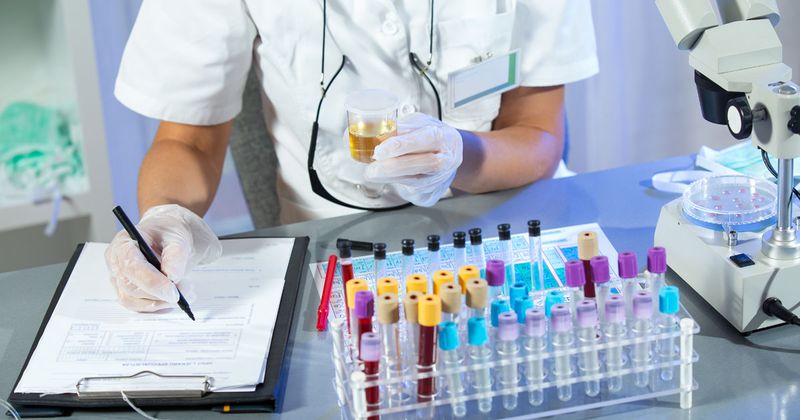Urine test detects high-grade prostate cancer, can reduce unnecessary biopsies
Key takeaways:
- A urine-based test helped reduce unnecessary biopsies among men with prostate cancer.
- The test appeared to be very strong in detecting high-grade cancers.
A new urine-based test for men with prostate cancer can distinguish the slow-growing form of the disease from the more aggressive type that would require immediate treatment, according to study data published in JAMA Oncology.
If implemented across health care practice, the test could help reduce unnecessary biopsies while still allowing for the detection of high-grade cancers, researchers said.

“Noninvasive tests to detect high-grade prostate cancer are needed,” Arul M. Chinnaiyan, MD, PhD, director of Michigan Center for Translational Pathology, told Healio.
“The MPS2 test performs better than the existing tests on the market. The use of this test in patients with elevated PSA levels will reduce the potential harms of conventional prostate cancer screening while preserving its long-term benefits,” he added. “This is an ideal test to run in men with elevated PSA in order to identify men who are at low risk for high-grade prostate cancer.”
Background, methods
The clinical value of prostate cancer screening with PSA alone is lacking due to excess negative biopsies and over-detection of nonaggressive cancers due. This is because PSA has poor specificity for the detection of high-grade prostate cancer, according to background information provided by study investigators.
Researchers sought to develop a multiplex urinary panel to detect high-grade prostate cancer and validate its performance relative to current guideline-endorsed biomarkers.
Researchers conducted RNA sequencing analysis of 58,724 genes to identify 54 markers of prostate cancer, 17 of which are specifically overexpressed by high-grade cancers. Next, they utilized gene expression and clinical factors to model a new urinary test for high-grade prostate cancer, MyProstateScore 2.0 (MPS2).
Models were created in parallel with and without prostate volume; optimized models then underwent blinded external validation in a prospective NCI cohort trial.
Researchers collected data from January 2008 to December 2020, with data being analyzed from November 2022 to November 2023.
Various biomarkers were assessed in the validation cohort, including serum PSA alone, the Prostate Cancer Prevention Trial risk calculator and the Prostate Health Index.
Using an approach with 95% sensitivity for prostate cancer of grade group 2 or higher, researchers measured diagnostic accuracy and clinical consequences of testing.
The development cohort included 761 men (median age, 63 years), whereas the validation cohort included 743 men (median age, 62 years).
Results
Among men in the validation cohort, 151 (20.3%) had high-grade prostate cancer on biopsy. Researchers noted area under the receiver operating characteristic curve values of 0.6 using PSA alone, 0.66 using the risk calculator, 0.77 using the Prostate Health Index, 0.76 using the derived multiplex 2-gene model, 0.72 using the derived multiplex 3-gene model and 0.74 using the original MPS model, compared with 0.81 using the MPS2 model and 0.82 using the MPS2+ model.
With a 95% sensitivity, the MPS2 model would have reduced unnecessary biopsies performed in both the initial biopsy population and repeat biopsy population.
Across pertinent subgroups, researchers noted that the MPS2 models had negative predictive values of 95% to 99% for cancers of grade group 2 or greater and of 99% for cancers of grade group 3 or greater.
One potential study limitation includes limited racial diversity; with Black men being at an increased risk for prostate cancer, researchers are currently pursuing analyses to ensure optimal testing for all patients.
Next steps
This new 18-gene prostate cancer test exhibited higher diagnostic accuracy for high-grade prostate cancer relative to existing biomarker tests, according to researchers. Additional study is being done to address a lack of testing of a racially diverse study population, but researchers are also seeking to evaluate the tests effectiveness in other ways among patients with prostate cancer.
“We were surprised that the test performed equally well in the development and validation cohorts,” Chinnaiyan told Healio. “Sometimes one sees a deterioration in performance in the validation cohort, but in this case we did not — suggesting the robustness of the model and biomarkers used in this study.
“Future research will address whether this model and set of biomarkers will also be useful to detect high-grade disease in men diagnosed with prostate cancer but considering active surveillance,” he added.
For more information:
Arul M. Chinnaiyan, MD, PhD, can be reached at arul@med.umich.edu.
